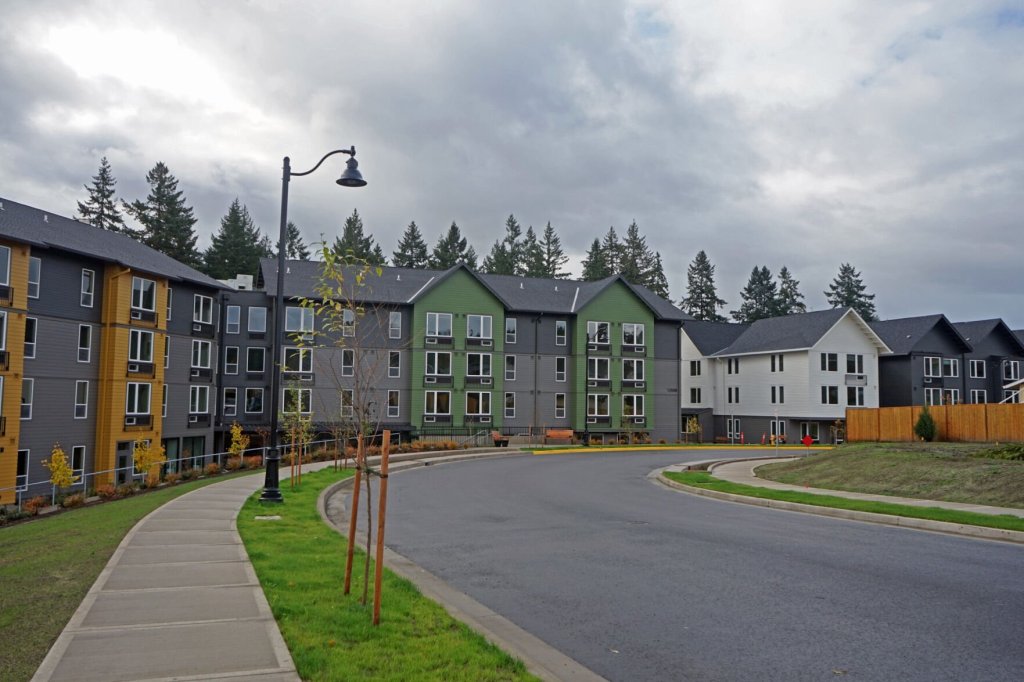West Linn adopts housing production strategy, to begin implementation next year
Published 11:03 am Wednesday, May 14, 2025

- Good Shepherd Village, a 143-unit affordable housing complex opened in 2023 in Happy Valley. (Submitted by Lauren Everett, Metro)
Beginning next year, the city of West Linn will implement about a dozen new strategies for increasing housing supply including land rezoning, tax exemptions for multifamily units or low-income rental housing, land acquisition and banking for affordable housing developments and more.
These strategies are outlined in the city’s Housing Production Strategy, which the City Council adopted Monday, May 12 in order to comply with rules outlined in HB2003, a bill passed by the Oregon Legislature in 2019 to address the state’s housing crisis.
HB2003 required cities to analyze current and future housing needs and how much land is available for new housing. That analysis found West Linn will need 327 more housing units affordable to people earning 80% or less of the area’s median income by 2040. The bill also required cities to develop a housing production strategy to help meet the needs identified in the analysis.
Trending
West Linn city staff, planning consultants and a working group of community members and impacted parties helped craft the strategy for over a year.
At the May 12 council meeting, Matt Hastie, the consultant who helped the city develop the plan, broke down the 12 strategies into three categories: housing option and choice actions, affordable housing options and equitable housing opportunities.
Strategies under the first category include rezoning land, the development of smaller housing units, scaling system development charges to the size of a home, reducing or waiving SDCs for certain developments and tax exemptions for multiunit properties. These strategies are meant to provide community members a broader range of housing options and prices.
The second category, affordable housing options, includes strategies such as use of tax increment financing for affordable housing projects (the city has established a TIF district along the Willamette River waterfront and is considering one for the Highway 43 corridor), acquiring and banking land for development of affordable housing, partnerships with private parties to develop affordable housing, tax exemptions for low income rentals, zoning incentives and a construction excise tax.
Hastie noted the construction excise tax was the only strategy to receive pushback from members of the working group. A construction excise tax would tax new construction projects within the city to bolster affordable housing programs and support housing development incentives like permit fee and SDC reductions or tax abatements. For residential developments, the tax could not be more than 1% of a project’s permit value.
Mayor Rory Bialostosky noted that the excise tax received pushback in other communities, such as Lake Oswego – which ultimately opted against it – but did not seem to elicit the same level of resistance in West Linn’s discussions.
Trending
Because the tax was met with some resistance, the planning commission recommended pushing back its implementation from 2026 through 2028 to 2028 through 2030, which the City Council ultimately agreed with.
Though Lake Oswego opted against the excise tax, Hastie mentioned that other cities in the region, like Tigard, Beaverton and Milwaukie, have adopted the tax. He said, in Milwaukie, the tax helped attract $40 million in outside funds for an affordable housing development.
The third category of strategies, “equitable housing opportunities,” includes a homeowner opportunity limited tax exemption program for first time homebuyers with low or moderate incomes and fair housing policies and services.
Before the council voted unanimously to adopt the production strategy, Council President Mary Baumgardner said it’s also important that the city’s housing policies encourage young families to move to West Linn so that the West Linn-Wilsonville School District does not have to consider closing schools.







